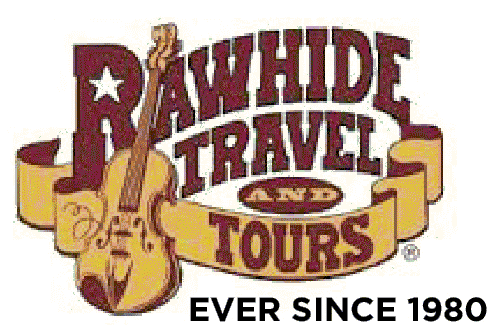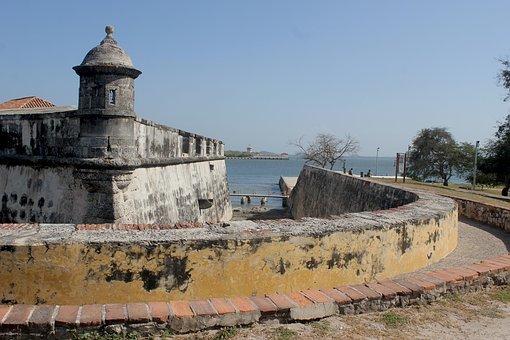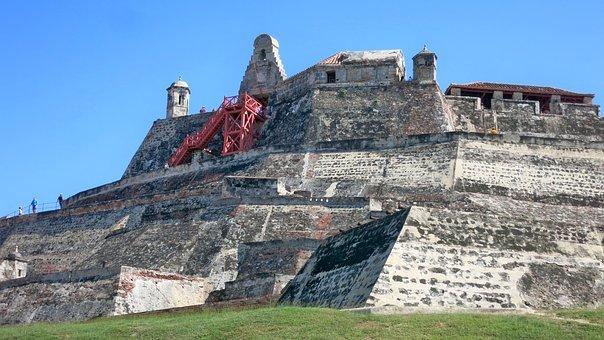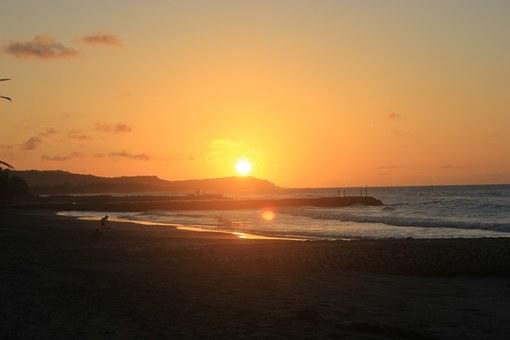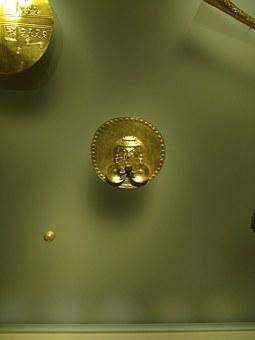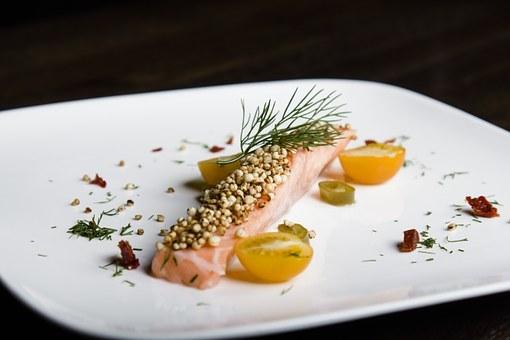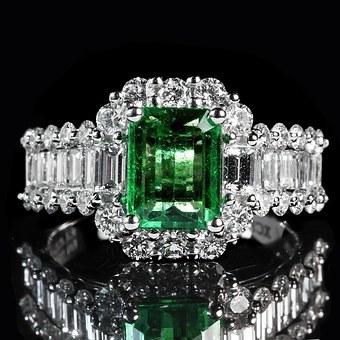Cartagena is a port city on Colombia’s Caribbean coast. This “walled Old Town by the sea” was founded in the 16th century and it’s quaint old-world feel with its rich history, cobblestone streets and colorful colonial buildings, is quite a sight to see. Cartagena is a popular beach destination because of its tropical climate, white-sand beaches and palm trees. And…it’s close proximity to Islas del Rosario – known for its exquisite coral reef is also a plus.
The historic clock tower gate is the main entrance into the city. The great walled city, protected by a fortress, was once used to shelter the city from pirates and storms. Within this small sector in the heart of the city, you will find an incredible array of bars, restaurants, shops and some beautiful (and rather expensive) hotels. Despite it being filled with tourists pretty much all year round, this historic corner of the city has not lost its charm. When you have the opportunity to visit Cartagena, make sure you can visit these unforgettable places either within or close to the city.
1. Castillo de San Felipe de Barajas
You cannot visit Cartagena without making a trip up to this historic castle which peers out over the city. Interestingly enough, this grand construction was started in 1639 but not completed until 150 years later. Since its completion it has been the crowning landmark in the city and visitors can now stroll through the battlements, weave their way through underground passages and admire the impressive architecture.
This secret wonder of the world is one of the most awe-inspiring fortresses in the entire continent and is one of Cartagena’s most famous and formidable sites. The colonial-era castle will forever be known as the most impregnable fortress ever built by the Spanish in the Americas. The unconquerable one – the one that could never be breached.
In the 1600’s San Felipe Castle’s main aim was to defend the Spanish Caribbean trade of Cartagena – with its immense natural resources of gold, silver, cacao, tobacco and chilli. At that time, piracy was prevalent in the region so looting occurred from the farms and mines to the ports and even the seas. In fact, Cartagena was the capital of trade back then and the city was easy enough to breach both by land and sea until the 11km defensive wall was built around the entire city. In addition, the city’s walls were dotted with cannons and backed up by a complex of forts. So even though intruders may take one or two of the forts, none were able to penetrate all of them so the city remained safe and secure for its inhabitants and their natural resources.
The climb to the top of the castle is a strenuous one but it’s worth the walk. You will not behold the breathtaking, sweeping views of Cartagena like this anywhere else. The castle’s 360-degree views were a necessity when guarding the city, and are today’s most outstanding bonus when visiting. On one side is colonial Cartagena, with its domed churches and red-tiled roofs. On the other, modern Cartagena, with high-rise office buildings reflecting the sun in their oversized glass facades – A superb frame of over 400 years of history.
2. Playa Blanca
Playa Blanca is undoubtedly one of Colombia’s most beautiful beaches. Approximately 45 minutes by boat from Cartagena or a two-hour car ride from the main city, it is located on Baru Island. Crystal-clear waters lap the perfectly white sand and visitors have the option to spend a day relaxing on this incredible beach or stay the night. If you come for the day you will enjoy the beach and also taste some delicious fresh fish served alongside coconut rice. For those who stay the night, you will experience the complete stillness and silence of waves caressing the white-sand beaches and calming sounds of the sea.
3. Museo de Oro – The Gold Museum.
Almost every large Colombian city has a gold museum and Cartagena is no exception. The Museo de Oro hosts a fantastic collection of gold and pottery of the Zenú people, who inhabited the areas around Bolívar, Córdoba, Sucre and northern Antioquia before the Spanish Conquest. Although small, this is one of the most famous museums of South America – containing more than 55,000 pieces of gold and other materials from Columbia’s major pre-Hispanic cultures. Look out for special exhibitions and guided tours offered in both English and Spanish. The Museum of Gold is one of the most visited touristic highlights in the country – receiving around 500,000 tourists per year.
The collection is laid out in logical, thematic rooms over three floors. Exhibitions begin on the second floor and are broken down by region, with descriptions of how pieces were used. There is a large mixture of animals rendered in gold like the jaguar-frog and human-eagle.
The 3rd-floor ‘Offering’ room exhibits explain how gold was used in ceremonies and rituals. There is strong indication of Zenu women playing major roles in worship. Some of the displayed tunjos (gold offerings, usually figurines depicting various aspects of social life) were thrown into the Laguna de Guatavita. The most famous one found near the town of Pasca in 1969, is the unlabeled gold boat called the Balsa Muisca. It’s uncertain how old it is, as generally only gold pieces that include other materials can be carbon dated.
4. Coastal Favorites.
Since Cartagena is a coastal city, it makes sense that many of the favorite dishes involve some sort of fish or seafood…or both. However, Cartagena is ceviche-mad. The dish arrived to Cartagena from the North of Colombia and also from many Peruvian restaurants that have set up shop there. There’s different versions depending upon the origins, but basically it involves raw fish and seafood cooked in a marinade of limes, oil, garlic, onion, tomato, and herbs. The Peruvian version also includes crunchy toasted corn kernels.
Mojarra is a favorite dish and is very famous around the world. It contains a whole fish with coconut rice, golden fried patacones (mashed and fried plantains) and a simple salad.
Pan de Bono. Although accepted to have originated in Cali, these delicious chewy-moist bread rolls are a favorite throughout Cartagena. They are made of corn flour, yuca and cheese – which makes them very moist. If you have the opportunity to have them fresh out of the oven they are pretty-much irresistible.
The array of Tropical Fruits in Cartagena is delightful. Eat them as juices, ice-creams or on their own. Some of these fruits such as Lulo, Nispero, Grenadilla, Papaya, Mango, Mora, Corozo, and Mamoncillo are hard to find outside of Columbia and its close neighbors.
And…for dessert…Tres Leches are made from vanilla sponge cake drenched in cow’s milk, condensed milk and a kind of caramel milk. This dessert is very sweet so you can share with your fellow traveler.
5. Emeralds
Colombia is famous for several different exports, but few people know that Colombian emeralds account for 70–90% of the world’s emerald market and are said to be among the purest emeralds in the world.
Colombian emeralds are globally famous for their quality, and many people come to Colombia with the idea of taking home a beautiful gem for themselves or as a gift. However, there are important things to be aware of when looking to purchase an emerald.
Buying emeralds in Colombia is easy to do but there are several things to be aware of. You would obviously want to get the purest gemstone for the best deal possible. The most important thing to be aware of when buying a Colombian emerald is the quality of the stone versus the price – which can range from $30–50 US dollars to over $10,000 – depending on the quality of the stone. Those that cost closer to $50 are younger emerald formations which are more opaque, light in colour and probably have a more turquoise-like hue than deep green.
The emeralds that are priced at thousands of dollars formed almost 40 million years ago and are translucent and dark green. Even a tiny little stone of this quality is going to cost a minimum of a few hundred dollars. While the color of the stone is key in determining price, it’s also important to inspect the stone for inclusions.
It’s also important to be aware of buying fake emeralds. The most reputable dealers do not deal in fake emeralds. But just to be sure, spot fakes for yourself easily enough by holding your ‘emerald’ up to a light or magnifying glass and checking for inclusions. A completely perfect stone, without a single inclusion is likely to be fake.
If you do decide to buy emeralds or emerald jewelry in Colombia, then you can rest assured that you will be buying a beautiful stone from the home of the world emerald trade.
References for this article:
The Top 9 Things to See and Do in Cartagena, Colombia
Cartagena / See & Do
By:
Eve Bidmead
Updated: 3 January 2019
Everything You Need to Know About Buying Emeralds in Colombia
by: Chris Bell
Updated: 1 August 2017
